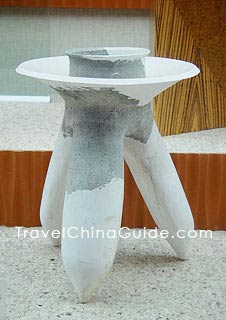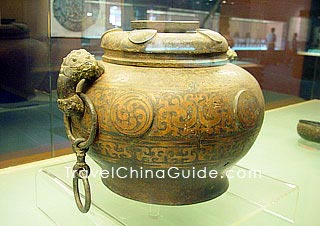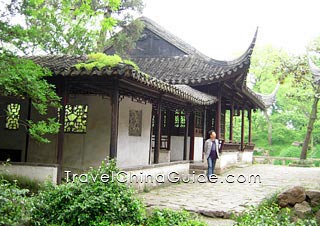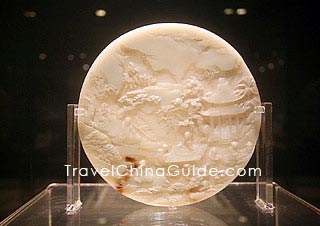Yangtze Culture Evolution
 |
| Grey Ware, Sanxingdui Museum |
Yangtze River has borne witness to Chinese history throughout the ages. It has seen the solemnity of Qin Dynasty (221 BC-206 BC), the grandeur of Han Dynasty (206 BC-220), the glory of Tang Dynasty (618-907) and the pomposity of Song Dynasty (960-1279). Being a cradle of Chinese ancient culture, the river embraces Bashu Culture in its upper reach, the culture of Jingchu in the middle reach and the culture of Wuyue in the lower reach.
Bashu Culture
Ba refers to Chongqing, and Shu refers to Sichuan. Bashu Culture means the regional culture centered by Chongqing and Sichuan, including the minority culture in some parts of the surrounding regions, extending to Tianshui and Hanzhong to the north, and eastern Yunnan and western Guizhou to the south, to give a specific division. Bashu Culture is an important component of Chinese culture. It has a long history which originated from the late Neolithic Age. Having experience the Grey Ware Culture Age, Jade Culture Age and Bronze Age, Bashu Culture generally became mature and splendid. Sanxingdui Museum, the great archeological discovery of ancient Shu, is a strong proof of glorious jade and bronze culture in Sichuan. Geographically speaking, Bashu is a basin land which is secluded from the outside world in the old days when the transport was difficult. Under this unfavorable condition, the local industrious people have made great effort to build ways to communicate with the outside. They creatively laid plank road along the cliffs to fight a way out. This has formed important features in Bachu Culture, that is, open and inclusive.
Jingchu Culture
 |
| Bronze Water Jar, Hubei Provincial Museum |
Jingchu refers to Hubei Province which was the political, economic and cultural center of ancient Chu state. Jingchu Culture was born in Hubei Province. It is endowed with strong regional features and composed of the following sub-cultures: Emperor Yan and Shennong Culture, Chu State, Qin (221 BC-206 BC), Han (206BC-220) and Three Kingdoms (220-280) Culture, Qingjiang Batu Culture, Three Gorges Culture, Wuhan Culture, Famous Mountains and Temples Culture, and Modern Revolution Culture. From the material aspect, Jingchu Culture is reflected in the fine handicrafts such as silk and embroidery works, exquisite bronzes, woodworks and lacquer wares; folk customs such as sacrifice, worship, poetry, chime bell, and unique ways to sing and dance; architectures such as palaces and terraced buildings. From the aspects of national spirit, we can see people living in this land are creative, initiative, patriotic, and dare to challenge with the old and unreasonable things.
Wuyue Culture
 |
| Humble Administrator's Garden, Jiangsu |
Centered by Taihu Lake, Wuyue Culture has influenced today's Jiangsu, Zhejiang, Shanghai, northeastern Jiangxi and eastern Anhui Provinces. Its features can be concluded in four points. First, born in the ideal environment with charming landscape, Wuyue Culture is fine and delicate. People living in this area emphasize on education and respect the talent. Second, it is all-embracing broadness. As a famous Chinese saying goes, "One place raises its own type of people", and this area, surrounding Taihu Lake, bordering Yangtze River and facing the sea, the broad space endows local people with the pioneering spirit. Third, it encourages on surpassing oneself, daring to be first and bold in trying new things. Fourth, it advocates the virtues of honesty and trustworthiness, pragmatism and kindness. These four parts have made Wuyue Culture so different from under regional cultures in China.
Liangzhu Culture
 |
| Jade Screen, Hangzhou History Museum |
Liangzhu Culture, about 5,300 to 4,000 years ago, is an important old culture of Taihu Lake Valley, the downstream of the Yangtze River. The archaeological studies prove that the agriculture in China has already entered the plowing age during this period. Besides, the handicraft industry tended to specialization and the jade carving industry was especially developed at that time. The appearance of big jade ritual objects uncovered the prelude of Chinese ceremony civilization. It is believed the sites of Liangzhu Culture will become the holy land of demonstrating the 5,000 years' Chinese civilization.
Along the banks of the river, historic relics like those in Xia, Shang and Zhou Dynasties can be admired. The ancient architecture and cultural relics make a Yangtze River cruise not only for those who want to appreciate its natural beauty but also for those who want to view its long history and glorious culture. For appreciating religious architecture relics, Shibaozhai is a good choice, and to admire the stone carving relic, visitors are recommended to go to Baiheliang (White Crane Ridge). Strolling among these notable historic relics while pondering the related background knowledge, you will find the trip to Yangtze River so memorable and valuable.
How does Yangtze River civilization affect China?